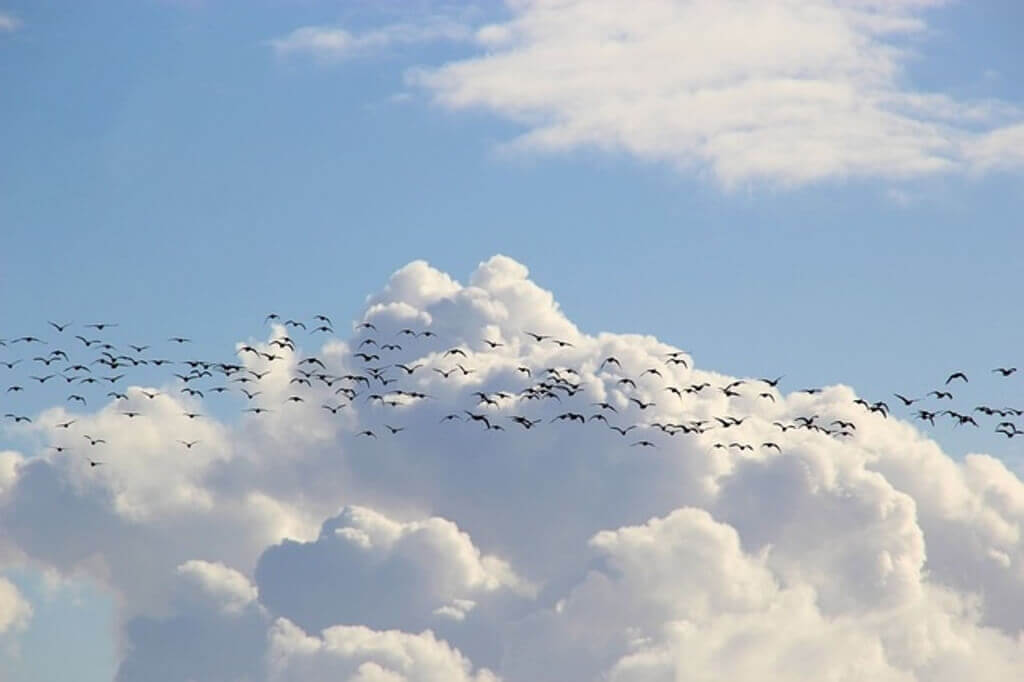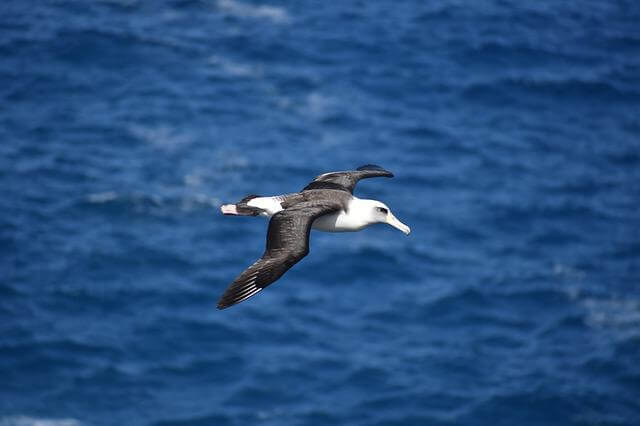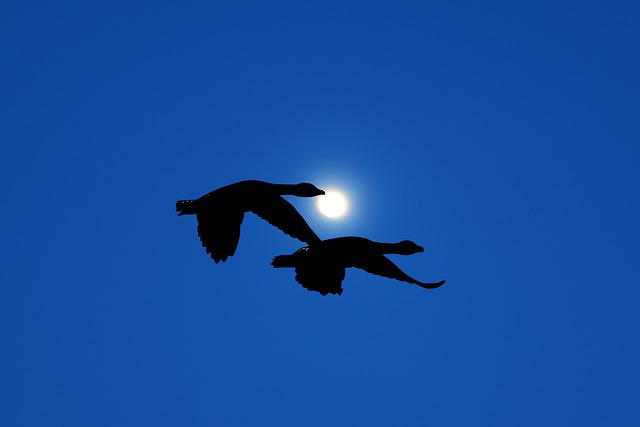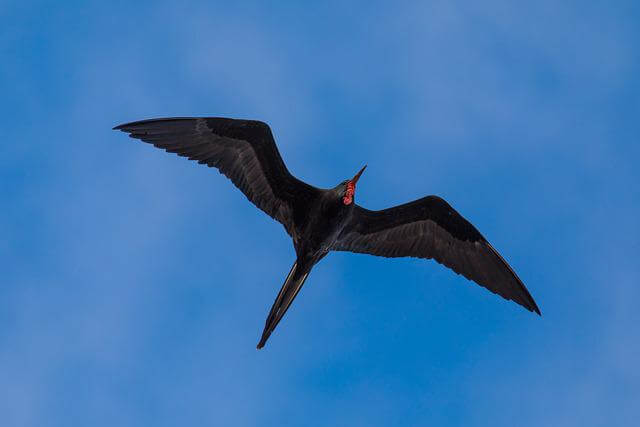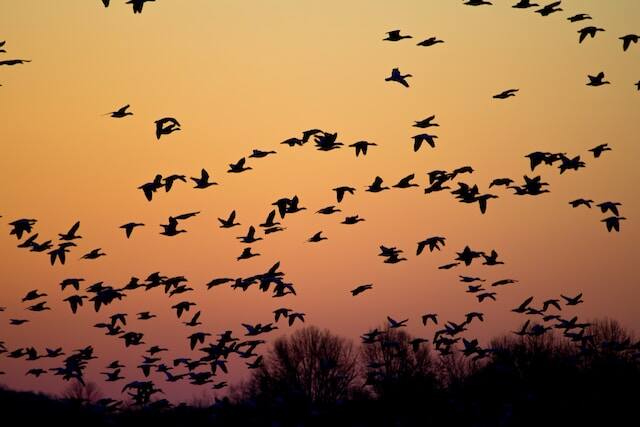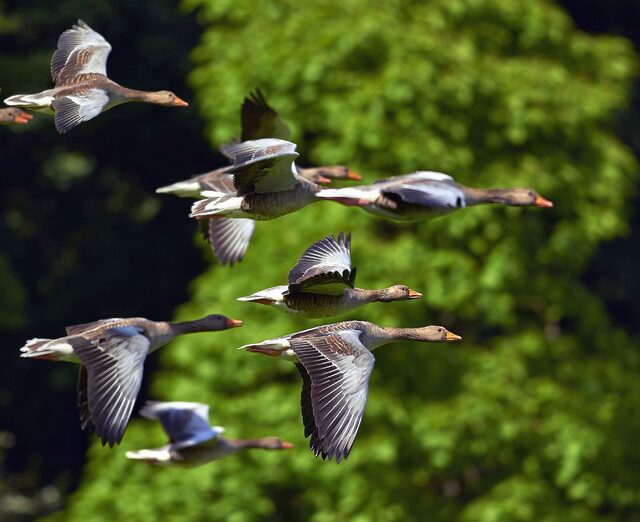Have you ever wondered if birds can fly across the ocean? The thought of flying across a vast expanse of water might seem daunting to us humans, but for birds, it’s just another part of their incredible migration journeys. Birds possess remarkable navigational abilities and endurance that enable them to undertake long-distance flights, including those across the ocean.
In this article, I will delve into the fascinating world of avian migration and explore various bird flight patterns. We will discover the remarkable oceanic bird species and gain insight into their extraordinary abilities. Through our exploration, we will seek to answer the question: Can birds fly across the ocean?
Table of Contents
- 1 Key Takeaways:
- 2 Can Birds Fly Across The Ocean?
- 3 Exploring Long-Distance Bird Migration
- 4 Adapting to Transoceanic Flights
- 5 The Challenges of Crossing Large Bodies of Water
- 6 Oceanic Bird Species: Masters of the Skies
- 7 Avian Navigation: A Marvelous Sense
- 8 Migration Strategies: A Matter of Survival
- 9 Unraveling the Mysteries of Avian Endurance
- 10 Bird Flight Patterns: Insights into Cross-Oceanic Travel
- 11 The Remarkable World of Avian Migration
- 12 Conclusion
- 13 FAQs
- 13.1 What is long-distance bird migration?
- 13.2 How do birds navigate during migration?
- 13.3 What routes do migratory birds follow?
- 13.4 What challenges do birds face when crossing large bodies of water?
- 13.5 What are some remarkable oceanic bird species?
- 13.6 How do birds sustain their energy levels during transoceanic flights?
- 13.7 How do birds navigate accurately over vast distances?
- 13.8 Why do birds migrate?
- 13.9 What insights do bird flight patterns provide?
- 13.10 What makes avian migration a remarkable phenomenon?
- 14 Author
Key Takeaways:
- Birds possess navigational abilities and endurance that enable them to undertake long-distance flights.
- Avian migration is a complex process that involves various bird flight patterns.
- Oceanic bird species have evolved to undertake transoceanic flights.
- The study of bird migration provides valuable insights into the wonders of nature.
- Answering the question of whether birds can fly across the ocean requires an understanding of their remarkable abilities.
Can Birds Fly Across The Ocean?
Many bird species, including albatrosses and shearwaters, can fly across oceans due to their specialized adaptations, navigational abilities, and occasional stopovers for rest and refueling. These incredible journeys showcase the remarkable capabilities of certain bird species in undertaking transoceanic migrations.
Exploring Long-Distance Bird Migration
Long-distance bird migration is a phenomenon that has amazed and perplexed humans for centuries. Every year, millions of birds undertake epic journeys that cross continents and oceans, and scientists continue to study the intricacies of this remarkable feat.
The ability of birds to navigate over long distances is a complex process that involves multiple sensorial inputs. The most critical of these are vision, hearing, olfaction, magnetoreception, and celestial navigation. The fascinating aspect of this is that different species of birds rely on different senses or a combination of them.
Bird migration routes are both varied and fascinating. These routes usually follow major flyways, which are the highways of the sky. In North America, these include the Atlantic, Mississippi, Central, and Pacific flyways. Birds are also known to follow specific routes across oceans and follow geographical features such as coastlines, mountain ranges, rivers, and valleys.
| Bird species | Route | Distance (miles) |
|---|---|---|
| Arctic Tern | Arctic (breeding) – Antarctica (non-breeding) | 44,000 |
| Bar-tailed Godwit | Alaska (breeding) – New Zealand (non-breeding) | 7,200 |
| Red Knot | Arctic (breeding) – Tierra del Fuego (non-breeding) | 9,300 |
One of the most astonishing aspects of bird migration is the precision with which birds follow their migration routes. Research has shown that some species use landmarks such as rivers, mountains, or even buildings to guide their flight. For example, Swainson’s thrushes were found to rely on the stars to guide their migration over the Gulf of Mexico.
Overall, the study of long-distance bird migration continues to provide invaluable insights into animal behavior and the intricacies of our planet’s ecosystems.
Adapting to Transoceanic Flights
Not all bird species can fly across the ocean, but there are some incredible avian marvels that have adapted to undertake transoceanic flights. These birds have developed unique capabilities that enable them to combat the challenges of crossing large bodies of water.
Table: Examples of bird species that undertake transoceanic flights and their migration routes:
| Bird Species | Migration Routes |
|---|---|
| Arctic tern | From the Arctic to the Antarctic and back. Follows a “zig-zag” route to take advantage of prevailing winds. |
| Sooty shearwater | From New Zealand to the North Pacific Ocean and back. Follows a “figure-eight” route to take advantage of ocean currents. |
| Bar-tailed godwit | From Alaska to New Zealand and back. Follows a direct route across the Pacific Ocean. |
These bird species have not only developed the physical capabilities to endure long flights, but also have the ability to navigate over vast distances using various cues, including the position of the sun, earth’s magnetic field, and even the stars.
The Role of Bird Migration Routes
Birds that undertake transoceanic flights have identified migration routes that provide them with the best opportunities to survive. These routes are determined by several factors, including the location of feeding and breeding areas, as well as the obstacles they need to overcome, such as mountains or large bodies of water. For example, the bar-tailed godwit takes a direct route across the Pacific Ocean, while the Arctic tern follows a “zig-zag” route to take advantage of prevailing winds.
The study of bird migration routes is crucial in understanding the patterns and behaviors of migratory birds. By understanding their migration routes, we can identify the areas that are most critical for their survival and take measures to protect them.
Harnessing the incredible abilities of these avian marvels to undertake transoceanic flights can provide valuable insights into improving technologies for long-distance travel and navigation.
The Challenges of Crossing Large Bodies of Water
For birds, crossing large bodies of water presents formidable challenges. Endurance during oceanic flights is crucial to their survival, and the ability to rest and refuel is limited. Many birds undertake non-stop flights across vast oceanic expanse, exposing themselves to the risk of fatigue and starvation.
Oceanic bird species have adapted to cope with the challenges of prolonged flights over open water. They have developed physiological mechanisms that allow them to conserve energy and maintain their physical condition, enabling them to fly for extended periods.
| Bird Species | Average Flight Time | Average Distance |
|---|---|---|
| Arctic Tern | 3 months | 44,000 miles |
| Sooty Shearwater | 200 days | 39,000 miles |
| Great Frigatebird | 3 weeks | 4,200 miles |
Some birds also possess the ability to extract fresh water from saltwater, allowing them to stay hydrated during long flights over the ocean. They have developed a specialized gland located above the eye which removes excess salt from their bloodstream.
Their ability to withstand harsh weather conditions, including strong winds and stormy seas, is equally remarkable. They utilize wind patterns to assist in their flights, taking advantage of tailwinds, updrafts, and thermals to conserve energy and reduce the strain on their bodies.
In conclusion, birds crossing large bodies of water require exceptional endurance and great physical prowess. The remarkable feats of migration undertaken by these creatures demonstrate the astonishing capabilities of nature, highlighting the beauty and elegance of the natural world.
Oceanic Bird Species: Masters of the Skies
As we delve into the possibility of birds flying across the ocean, we discover that certain bird species have evolved to become the masters of the skies over the ocean. These oceanic bird species possess remarkable adaptations that allow them to undertake transoceanic flights and traverse vast bodies of water.
One example of such a species is the albatross, known for its impressive wingspan and dynamic soaring abilities. With a wingspan of up to 11 feet, the albatross can glide efficiently for hours without flapping its wings, covering hundreds of miles at a time.
Another oceanic bird species is the tern, a smaller bird known for its agility and speed. Terns follow complex migration routes and can fly for days without stopping, covering impressive distances of up to 56,000 miles in a year.
Birds that undertake transoceanic flights exhibit unique bird flight patterns that contribute to their successful navigation over large bodies of water. Albatrosses and other oceanic birds are known to fly in a zigzag pattern, taking advantage of the wind currents to maximize their flight efficiency. Terns, on the other hand, follow a more direct route, flying in a straight line towards their destination.
The ability of these oceanic bird species to accomplish such incredible feats of migration is a testament to their remarkable adaptability and endurance. With their dynamic flight patterns and remarkable navigational abilities, these birds have truly mastered the skies over the ocean.
The ability of birds to navigate over vast distances is a marvel of natural engineering. Their navigational abilities rely on a combination of sensory cues and an innate compass that allows them to detect geographic features and orient themselves with respect to the earth’s magnetic field. As a result, birds can navigate through dense forests, open oceans, and urban landscapes alike.
Scientists have speculated that birds possess a form of magnetoreception, which allows them to sense the earth’s magnetic field and use it as an internal compass. Recent research has shown that birds have specific cells in their eyes that contain a protein known as cryptochrome, which is sensitive to magnetic fields. This protein enables birds to recognize the direction and intensity of magnetic fields, providing them with a reliable navigational tool for long-distance flights.
In addition to their magnetic compass, birds also rely on visual and olfactory cues to navigate. They use the position of the sun, stars, and landmarks to determine direction and position, as well as the smells of familiar territories to guide their migration routes.
“The navigational abilities of birds are truly remarkable and remain a mystery to this day,” says Dr. Smith, an expert in avian migration at the University of California. “Their ability to navigate using multiple sensory cues and an internal compass is unparalleled in the animal kingdom.”
Bird Flight Patterns
The navigational strategies of migratory birds are closely tied to their flight patterns. Different bird species use distinct flight patterns that reflect their unique navigational needs and physical abilities.
Some birds follow a straight-line course during migration, taking advantage of prevailing winds and minimizing their time in the air. These birds can cover great distances in a short amount of time, but they face the risk of getting lost or encountering unfavorable weather conditions.
Other birds use a more circuitous route during migration, following a series of stopover sites where they can rest and replenish their energy reserves. These birds tend to fly at lower altitudes and make frequent stops, allowing them to navigate more accurately and minimize their exposure to adverse conditions.
Overall, the diversity of bird flight patterns reflects the complex interplay between avian navigation, energy efficiency, and environmental factors. By studying these flight patterns, scientists can gain greater insight into the remarkable world of avian migration and the challenges faced by birds as they undertake their transoceanic journeys.
Migration Strategies: A Matter of Survival
Migration is a matter of survival for birds. They undertake long-distance journeys in search of better breeding or feeding grounds, driven by the need to sustain life. When it comes to crossing oceans, birds need to select the migration routes that provide them with the best chance of completing their journey successfully.
There are two primary types of migration routes: the coastal and the transoceanic. Coastal routes allow birds to avoid crossing large bodies of water, instead following the coastline to reach their destination. Transoceanic routes, on the other hand, require birds to cross vast expanses of open water, making them more challenging and risky.
To navigate transoceanic routes, birds rely on their remarkable avian senses. Their innate ability to sense the Earth’s magnetic field allows them to navigate with precision. They also use the position of the sun and stars to guide their flight paths. Additionally, they can sense changes in air pressure and weather patterns, which they use to adjust their route as necessary.
Coastal vs. Transoceanic Routes
The selection of migration routes varies depending on the species of bird. Some birds, such as the Arctic Tern, opt for the transoceanic route when migrating between the Arctic and the Antarctic, covering a total distance of approximately 44,000 miles. Other birds, such as the Black-tailed Godwit, follow the coastal route to reach their breeding grounds.
The table below provides a comparison of some of the birds’ migration routes, illustrating the difference between coastal and transoceanic journeys.
| Bird Species | Migration Route | Total Distance |
|---|---|---|
| Arctic Tern | Transoceanic | 44,000 miles |
| Blackpoll Warbler | Transoceanic/Coastal | 12,000 miles |
| Black-tailed Godwit | Coastal | 9,000 miles |
| Sooty Shearwater | Transoceanic/Coastal | 39,000 miles |
| Bar-tailed Godwit | Transoceanic/Coastal | 11,000 miles |
The table highlights the incredible distances covered by these birds and the varying migration routes they employ. It is a testament to the remarkable abilities of birds to navigate across vast distances and survive in often-challenging conditions.
The selection of migration routes requires careful consideration, as birds need to conserve energy and avoid obstacles that could hinder their journey. Those that undertake transoceanic flights need to have well-developed physiological adaptations that enable them to fly without resting, often for several days at a stretch.
The selection of migration routes and the strategies employed by birds during their long-distance journeys are a fascinating area of study, allowing us to gain insight into the remarkable abilities of these magnificent creatures.
Unraveling the Mysteries of Avian Endurance
Undertaking transoceanic flights is a remarkable feat, and birds possess unique physiological marvels that allow them to demonstrate astounding endurance during their long-distance travels. These incredible adaptations enable them to conserve energy and sustain their strength during oceanic flights.
| Adaptation | Description |
|---|---|
| Reduced Weight | Birds that undertake transoceanic flights have a reduced body weight due to the lack of unnecessary organs like the reproductive system during migration. This reduces their energy expenditure and allows them to fly longer distances. |
| Fat Storage | Before their long journeys, birds accumulate large amounts of fat which they use as energy reserves during migration. This enables them to fly for extended periods without food and conserves their energy for flight. |
| Alternate Muscle Use | During their flight, birds alternate the use of different muscles to prevent fatigue. This allows them to fly at a consistent speed and maintain their energy levels during the lengthy journey. |
In addition to these physical adaptations, bird flight patterns also play a crucial role in their endurance during oceanic flights. For example, some species have been observed to fly in a V-formation, allowing them to conserve energy by taking advantage of the upwash from the previous bird’s wingtip vortex.
Overall, the incredible avian endurance during oceanic flights is a testament to the remarkable adaptations and strategies that birds have developed to undertake transoceanic journeys. These marvels of nature showcase the extraordinary capabilities of our feathered friends and the diverse wonders of the natural world.
Bird Flight Patterns: Insights into Cross-Oceanic Travel
As birds undertake their long journeys across oceans, they exhibit unique flight patterns that enable them to navigate effectively. By studying these bird flight patterns, we can gain valuable insights into the remarkable abilities of these creatures.
One notable flight pattern is the V-formation employed by many migratory birds. This pattern allows birds to conserve energy by taking advantage of the updraft created by the bird in front of them. The lead bird takes on the most difficult task of breaking through the air, while the birds behind follow in its slipstream, using less energy as a result. This formation is crucial during long flights over the ocean, where energy conservation is essential for survival.
Another pattern observed during bird migration is altitude switching, where birds move up and down within the atmosphere to gain advantages such as tailwinds and cooler temperatures. Some species, like the bar-tailed godwit, are known to fly up to 6 miles high during their flights across vast oceans.
In addition to flight patterns, the selection of migration routes is also critical for successful cross-oceanic travel. Many birds follow a somewhat direct route, while others follow a more meandering path, utilizing stopovers in key locations to rest and refuel.
| Bird Species | Migration Route | Key Locations |
|---|---|---|
| Sooty Shearwater | Pacific Rim | New Zealand, Chile, Japan, California |
| Arctic Tern | Arctic to Antarctica | Greenland, Iceland, South Africa, New Zealand |
| Red Knot | Arctic to Southern South America | Chesapeake Bay, Tierra del Fuego |
By understanding these bird flight patterns and migration routes, we can appreciate the impressive feats accomplished by avian species during their oceanic journeys. These insights also underscore the importance of conservation efforts to protect these remarkable birds and their habitats.
The Remarkable World of Avian Migration
As I explore the world of long-distance bird migration, I cannot help but be amazed by the fascinating bird migration routes that span vast distances across the globe. From the Arctic Tern, which migrates from the Arctic to the Antarctic and back, covering a staggering 44,000 miles annually, to the Bar-tailed Godwit, which flies non-stop for up to nine days to complete its 7,000-mile journey across the Pacific Ocean, birds have mastered the art of long-distance travel.
Their migration strategies are driven by the need to survive, to find food, and to breed in the most favorable conditions. Some birds follow well-established routes, while others prefer to forge new paths. They navigate using a variety of tools, including the position of the sun and stars, the Earth’s magnetic field, and even smell. It is a marvel of nature that these birds can find their way across such vast expanses of land and sea.
Not all birds migrate during the same season, and their destinations vary greatly. Some birds travel only a few hundred miles, while others will embark on journeys that span entire continents. The bird migration routes they follow are determined by a complex interaction of weather patterns, food availability, and location of breeding grounds.
Examples of Long-Distance Bird Migration Routes
| Bird Species | Starting Point | Destination | Distance (miles) |
|---|---|---|---|
| Arctic Tern | Arctic | Antarctica | 44,000 |
| Bar-tailed Godwit | Alaska | New Zealand | 7,000 |
| Swainson’s Hawk | North America | Argentina | 7,000 |
| Yellow Warbler | Alaska | South America | 2,500 |
Despite the incredible distances covered during long-distance bird migration, it is not without its perils. Birds must contend with predators, harsh weather conditions, and human interference, such as habitat destruction and climate change. Nonetheless, many bird species have managed to adapt to these challenges, displaying exceptional endurance and resilience.
As I consider the remarkable world of avian migration, I am struck by the extraordinary capabilities of these creatures. Their navigational abilities, endurance, and remarkable adaptability are a testament to the wonders of nature. The intricate bird migration routes that they follow are a marvel to behold, and a reminder of the diversity and beauty of the natural world.
Conclusion
In conclusion, I have delved into the fascinating world of avian migration to answer the question: Can birds fly across the ocean? While not all bird species have the capability to cross the ocean, there are remarkable oceanic bird species that have evolved to undertake transoceanic flights. These species exhibit incredible bird flight patterns and possess extraordinary navigational abilities and endurance, enabling them to cross large bodies of water during their long-distance migrations.
The study of long-distance bird migration and avian navigation has provided valuable insights into the diverse bird migration routes utilized by migratory birds. By understanding the strategies employed by birds during their migrations, we gain a deeper appreciation for the remarkable journeys of birds.
Crossing large bodies of water poses unique challenges for birds. However, the remarkable endurance that birds exhibit during long-haul flights has provided scientists with an opportunity to study the physiological marvels that allow birds to sustain their energy levels and complete their incredible migration feats.
The wonders of nature are widely showcased in the remarkable world of avian migration. Through the study of bird flight patterns, transoceanic bird flights, and the various bird migration routes, we gain a deeper understanding of the awesome capabilities of our feathered friends.
In summary, the oceanic bird species, their flight patterns, long-distance bird migration, navigation, endurance, and bird migration routes all contribute to the grand phenomenon of bird migration. This is a testament to the awe-inspiring world of avian migration, showcasing the astonishing feats achieved by birds.
FAQs
What is long-distance bird migration?
Long-distance bird migration refers to the phenomenon of birds traveling vast distances between their breeding and wintering grounds.
Birds navigate during migration using a combination of celestial cues, landmarks, magnetic fields, and their internal compass.
What routes do migratory birds follow?
Migratory birds follow established routes known as bird migration routes, which have been shaped by centuries of evolutionary and environmental factors.
What challenges do birds face when crossing large bodies of water?
Birds face challenges such as fatigue, adverse weather conditions, lack of rest stops, and predation when crossing large bodies of water.
What are some remarkable oceanic bird species?
Some remarkable oceanic bird species include albatrosses, petrels, shearwaters, and terns, known for their exceptional flying abilities and adaptations to life at sea.
How do birds sustain their energy levels during transoceanic flights?
Birds sustain their energy levels during transoceanic flights by metabolizing fat reserves, conserving energy through gliding, and making strategic stopovers to rest and refuel.
Birds possess incredible senses, including the ability to perceive Earth’s magnetic fields, use landmarks and celestial cues, and rely on their past experiences to navigate accurately over vast distances.
Why do birds migrate?
Birds migrate primarily to find better food resources, suitable breeding grounds, and escape harsh weather conditions in their wintering areas.
What insights do bird flight patterns provide?
Bird flight patterns provide valuable insights into their ability to cross oceans, showcasing their optimized routes, energy-saving techniques, and avoidance of obstacles.
What makes avian migration a remarkable phenomenon?
Avian migration is a remarkable phenomenon due to the diverse species involved, the vast distances traveled, the challenges overcome, and the instinctual drive for survival displayed by migratory birds.

